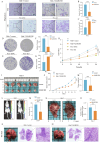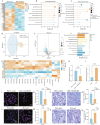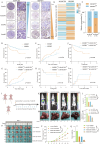MARCH8 suppresses hepatocellular carcinoma by promoting SREBP1 degradation and modulating fatty acid de novo synthesis
- PMID: 40379644
- PMCID: PMC12084374
- DOI: 10.1038/s41419-025-07707-9
MARCH8 suppresses hepatocellular carcinoma by promoting SREBP1 degradation and modulating fatty acid de novo synthesis
Abstract
Hepatocellular carcinoma (HCC) is one of the most prevalent malignant tumors of the digestive system, and its prevalence is currently increasing. The current study aims to elucidate the mechanism by which membrane-associated RING-CH8 (MARCH8) impedes the progression of HCC. MARCH8 was identified as a distinct prognostic marker for recurrence-free survival (RFS) and overall survival (OS) in patients with HCC. This study shows that MARCH8 hinders lipid deposition by suppressing the expression of key enzymes for the de novo synthesis of fatty acids (FAs) via RNA sequencing, untargeted metabolomics, and a series of in vivo and in vitro experiments. Further experimental validation demonstrated that MARCH8 was a novel E3 ligase of sterol regulatory element binding protein 1 (SREBP1). And, it primarily promoted the degradation of SREBP1, thereby suppressing the expression of key enzymes involved in the de novo synthesis of FAs. In conclusion, this study has identified MARCH8 as a key "switch" that can be targeted to prevent de novo FA synthesis in HCC cells. This finding may have substantial implications for discovering innovative therapeutic strategies for HCC.
© 2025. The Author(s).
Conflict of interest statement
Competing interests: The authors declare no competing interests.
Figures









References
-
- Villanueva A. Hepatocellular carcinoma. N Engl J Med. 2019;380:1450–62. - PubMed
-
- Llovet JM, Kelley RK, Villanueva A, Singal AG, Pikarsky E, Roayaie S, et al. Hepatocellular carcinoma. Nat Rev Dis Prim. 2021;7:6. - PubMed
-
- El-Serag HB. Hepatocellular carcinoma. N Engl J Med. 2011;365:1118–27. - PubMed
-
- Fujiwara N, Nakagawa H, Kudo Y, Tateishi R, Taguri M, Watadani T, et al. Sarcopenia, intramuscular fat deposition, and visceral adiposity independently predict the outcomes of hepatocellular carcinoma. J Hepatol. 2015;63:131–40. - PubMed
MeSH terms
Substances
LinkOut - more resources
Full Text Sources
Medical
Research Materials
Miscellaneous

